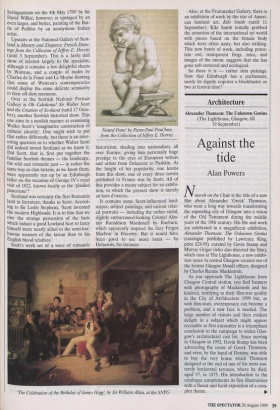Architecture
Against the tide
Alan Powers
Nineveh on the Clyde is the title of a new film about Alexander 'Greek' Thomson, who went a long way towards transforming the expanding city of Glasgow into a vision of the Old Testament during the middle years of the 19th century. His life and work are celebrated in a magnificent exhibition, Alexander Thomson: The Unknown Genius (catalogue published by Lawrence King, price £24.95), curated by Gavin Stamp and Murray Grigor (who also directed the film), which runs at The Lighthouse, a new exhibi- tion space in central Glasgow created out of the former Glasgow Herald offices, designed by Charles Rennie Mackintosh.
As you approach The Lighthouse from Glasgow Central station, you find banners with photographs of Mackintosh and his kindred, testifying to their film-star quality in the City of Architecture 1999 but, as with film-stars, overexposure can become a problem, and a new face is needed. The large number of visitors and their evident delight in a subject which might appear recondite at first encounter is a triumphant conclusion to the campaign to widen Glas- gow's architectural cast list. Since moving to Glasgow in 1992, Gavin Stamp has been advocating the cause of Greek Thomson, and even, by the hand of Destiny, was able to buy the very house which Thomson designed at the end of one of his most aus- terely horizontal terraces, where he died, aged 57, in 1875. His introduction to the catalogue complements its fine illustrations with a fluent and lucid exposition of a com- plex theme. l■ Alexander Thomson: The Unknown Genius is not only the product of enthusias- tic swimming against the tide, but the result of considerable research which was needed to assemble the fragmentary evidence of an architect whose documentary record has suffered in equal measure to his built work. Mackintosh also suffered a period of neglect and some of his buildings were destroyed, but never to the same extent. Nonetheless, Mackintosh's Hill House, Helensburgh, a grand suburban house of international importance, now has its coun- terpart in Thomson's The Holmwood, Cathcart, which was rescued by the Nation- al Trust for Scotland and is now open to the public.
Against what tide must a Thomsonian swim? The old answer might have been the unfashionability of the Victorian period, but this is combined, in the fishing grounds of the design culture elite, with an aversion to Classical architecture as an end in itself. Thomson was no ordinary Classical archi- tect, however, and his work carries an emo- tional charge which belies the customary accusation of conventionality, pomposity and copyism levelled against classicism. To the Classical adept, furthermore, it reveals the source of its strength in a depth of refer- ence combined with a skill in deploying not only the forms of the Renaissance, but those endless sublime colonnades and strange fruiting capitals which Romantic explorers discovered in Egypt and the Middle East.
Thomson, immersed in the Bible, saw himself, at least in his three large churches in Glasgow, as reconstructing the Temple of Solomon itself. The austerity of sand- stone masonry gave way in their interiors to a magnificent blaze of colour and stencilled pattern, still surviving in the St Vincent Street Church, and now recreated in a three-dimensional computer model for the Queen's Park Church, destroyed by a bomb in 1943, and acknowledged by all who saw it to have been the peak of its kind. Perhaps it is an oncoming tide of secular subjectivity (so well represented by Mack- intosh's inspired whimsy) that Thomson opposes with his own dream world, sup- ported by text and citation magnificently wrought into new form. For anyone inter- ested in entering Thomson's mind through the written word, the Alexander Thomson Society has published his lectures as The Light of Truth and Beauty (£9.95, available from 1 Moray Place, G41 2AQ).
During the period of Mackintosh's obscurity, in the two sad decades before his death in 1927, Thomson attracted a new following among architects to whom he offered a vision of a possible future archi- tecture. Whether such an architecture would be recognisably Classical or whether it would be abstracted to become some- thing called 'Modern' was a point of deci- sion at which two streams divided, although there were some, like the Glaswegian Thomas Tait, trained by a pupil of Thom- son, who recognised Frank Lloyd Wright as a mighty swimmer in the same waters and alternated between the Classical (Lloyds Bank in Lombard Street) and the Modern (Silver End Garden Village), alternately offering two potential outcomes. The Thomson exhibition concludes by pointing out some of the fascinating formal similari- ties between Wright and his precursor, although there is no evidence of a direct transfer of knowledge. At least the Ameri- can historian Henry-Russell Hitchcock, one of Wright's greatest supporters, also recog- nised the supreme quality of Thomson's work and when it, in turn, was subject to neglect he intervened to save what was left of the Caledonia Road church after a fire in 1965.
Now that Thomson is so well reseated to face Mackintosh, the possibility opens up of a renewed Glaswegian dialectic, not in the exhausted field of Classical and Mod- ern, but between the Classical and Roman- tic imaginations, in which the dynamism of Holmwood House designed by Alexander 'Greek' Thomson the flowing river is what matters, rather than the victory of one over another. In the past, this source of energy has illuminated the wider world from its starting point in Glasgow, and it could do so again as a new model of the value of localised culture.



























































 Previous page
Previous page